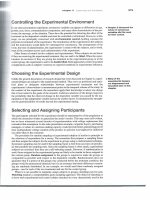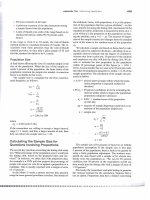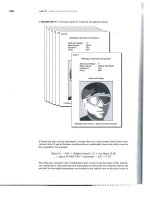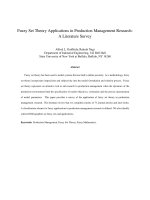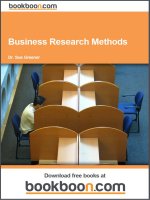Management research methods CamBridge
Bạn đang xem bản rút gọn của tài liệu. Xem và tải ngay bản đầy đủ của tài liệu tại đây (27.32 MB, 352 trang )
This page intentionally left blank
Management Research Methods
Management Research Methods is a comprehensive guide to the design
and conduct of research in management-related disciplines such as
organisational behaviour, human resource management, industrial
relations, and the general field of management. The book provides an
overview of the research process and explains the main types of design
used in management research – experimental and quasi-experimental
designs, correlational field studies (surveys), case studies, historical
analysis, and action research. It also describes the methods of data collection – interviews, questionnaires, documentation, and obsevation –
commonly employed by management researchers. In addition, the
book examines the issues of reliability and validity, the construction
of multi-item scales, and the methods of quantitative and qualitative
analysis. It concludes with a practical guide explaining how to report
research findings and a discussion of ethical issues in the conduct and
practice of research.
Management Research Methods is an essential guide for students, managers and researchers.
Phyllis Tharenou is Dean of Research in the Division of Business,
University of South Australia.
Ross Donohue is a lecturer in the Department of Management, Monash
University.
Brian Cooper is a lecturer in the Department of Management, Monash
University.
Management
Research
Methods
PHYLLIS THARENOU, ROSS DONOHUE,
AND BRIAN COOPER
CAMBRIDGE UNIVERSITY PRESS
Cambridge, New York, Melbourne, Madrid, Cape Town, Singapore, São Paulo
Cambridge University Press
The Edinburgh Building, Cambridge CB2 8RU, UK
Published in the United States of America by Cambridge University Press, New York
www.cambridge.org
Information on this title: www.cambridge.org/9780521694285
© Phyllis Tharenou, Ross Donohue, Brian Cooper 2007
This publication is in copyright. Subject to statutory exception and to the provision of
relevant collective licensing agreements, no reproduction of any part may take place
without the written permission of Cambridge University Press.
First published in print format 2007
eBook (EBL)
ISBN-13 978-0-511-29498-3
ISBN-10 0-511-29498-0
eBook (EBL)
ISBN-13
ISBN-10
paperback
978-0-521-69428-5
paperback
0-521-69428-0
Cambridge University Press has no responsibility for the persistence or accuracy of urls
for external or third-party internet websites referred to in this publication, and does not
guarantee that any content on such websites is, or will remain, accurate or appropriate.
Contents
Preface
page vii
Part 1 Introduction
1 The research process
Part 2 Research designs
2
3
4
5
Experimental and quasi-experimental designs
Correlational field study (survey) designs
Case study research designs
Action research designs
Part 3 Methods of data collection
6 Asking questions: Questionnaires and interviews
7 Documentation and observation
Part 4 Measurement
8 Reliability and validity
9 Scale development
Part 5 Methods of data analysis
10 Quantitative data: Data set-up and initial analysis
11 Quantitative data: Multivariate data analysis for answering
research questions and hypothesis testing
12 Content analysis
Part 6 Reporting research findings and ethical
considerations
13 Writing up a quantitative or qualitative project
14 Ethical issues and conduct in the practice of research
Index
1
3
31
33
45
72
88
99
101
123
147
149
160
187
189
220
250
273
275
316
329
Preface
In order to conduct sound research in the discipline of management,
it is critical that you develop an awareness of research approaches and
techniques. The purpose of this text is to foster your capacity to understand the appropriate method of research to undertake and what outcomes you could reasonably expect from that research. By using this
text, you will be encouraged to become critical of the use of different
techniques and methods applied in this research field.
Aims and objectives
The aim of this text is to develop your understanding of the research
process suitable for the management discipline. Having completed this
text, it is expected that you will be able to:
r
r
r
r
r
r
r
critically analyse, interpret, and understand basic research designs
in the management discipline;
identify management-related issues for research;
build the capacity to develop research questions grounded in a theoretical and conceptual framework;
compare the appropriateness and use of qualitative and quantitative
data collection and analysis techniques as a means of investigating
and answering research questions in the management discipline;
outline the process of collecting primary data, and identify, search for,
and locate secondary data and knowledge relevant to management
research;
summarise the role and introductory use of computer software packages and facilities in the collection, analysis, and presentation of
research findings;
demonstrate a general understanding of the role of management
research in academic, industry, government, and professional and
community organisations; and
vii
viii
r
Preface
develop academic writing skills appropriate to the discipline for
reporting on business management research projects.
Text content
Every day, managers are involved in designing projects, jobs, organisational or departmental structures, and ways of matching individual
and group needs in organisations. They base their decisions on existing
knowledge resulting from what they or others have learnt from applied
or pure academic research. In fact, designing questions to solve management problems is such a fundamental skill that we overlook its
significance as a major factor contributing to quality management.
Management Research Methods aims to foster in readers an understanding of the basic research processes and a capacity to identify
management-related research questions. Readers will learn the manner in which others have designed and conducted research studies to
answer management-related questions, the sources of the main existing literature in management-related studies, the procedures involved
in collecting primary data, the purposes of techniques for analysing
and presenting data, and the necessary structuring and writing skills
to generate a research report.
This text therefore provides a basic introduction to research design
in management, types of research designs, data collection and measurement techniques, coding data, reliability and validity, qualitative and
quantitative methods of analysis, interpreting and discussing results,
structuring and writing the research report, and integrating individual
research into the overall management literature.
Organisation
This text is organised into six parts. Part 1, Introduction, contains Chapter 1, which outlines the research process, discusses foundational issues,
defines key terms, and provides readers with an overview of topics discussed more comprehensively in subsequent chapters. Part 2, Research
Designs, is comprised of chapters examining experimental and quasi-
Preface
ix
experimental designs (Chapter 2), correlational field study (survey)
designs (Chapter 3), case study research designs (Chapter 4), and action
research designs (Chapter 5). Part 3 of the book is focused on Methods
of Data Collection and includes chapters on asking questions using questionnaires and interviews (Chapter 6) and documentation and observation (Chapter 7). Part 4, Measurement, consists of chapters discussing
reliability and validity (Chapter 8) and scale development (Chapter 9).
Part 5 of the text groups the Methods of Data Analysis and contains
chapters on quantitative data set-up and initial analysis (Chapter 10),
quantitative multivariate analysis (Chapter 11), and content analysis
(Chapter 12). Reporting Research Findings and Ethical Considerations is
the final part and comprises chapters on writing up a qualitative or
quantitative project (Chapter 13) and ethical issues and conduct in the
practice of research (Chapter 14).
Learning outcomes
The main components involve:
r
r
r
r
r
r
r
developing a critical understanding of basic research designs (for
example, experimental and quasi-experimental designs, correlational field study designs, case study designs, and action research
designs) in order to conduct applied management research;
developing skills in designing research studies in relation to contemporary management issues, including ethical considerations in
design;
devising or locating techniques to generate or collect primary data,
and identifying and locating sources of secondary data;
developing basic, introductory skills in data collection – for example, interviewing, using questionnaires, observation techniques, and
documentation;
developing skills in the construction of multi-item scales;
developing an understanding of basic data analysis concepts in relation to answering research questions and testing hypotheses;
developing skills in writing up an academic research study in formal
research report format; and
x
r
Preface
having an appreciation of the overall steps in research design and of
integration of the individual research skills that comprise effective
research designs in management.
Having completed the text, readers will be able to:
r
r
r
r
r
r
r
prepare research questions both from applied and theoretical perspectives for management research;
conduct computerised literature searches for management research;
prepare research designs for a range of management research
questions;
design and conduct research in keeping with ethical considerations;
identify and locate sources for data collection and design questionnaires, interviews, and multi-item scales;
appreciate the broad purpose and applicability of data analytic techniques for quantitative and qualitative data analysis; and
develop skills in writing an academic research report.
Acknowledgements
The authors gratefully acknowledge Cathy Miles for her meticulous
assistance during the editing process of this book and for her assistance during the production stages. The authors are also appreciative
of the excellent support and guidance provided by Cambridge University Press, specifically the managing editor, Kate Indigo, as well as the
freelance editor, Robyn Fleming.
Part 1
Introduction
1 The research process
Objectives
At the end of this chapter you will be able to:
r
r
r
r
r
r
r
r
r
r
r
r
r
r
describe the overall research process;
describe each step in the research process and explain why it is conducted;
develop a research question and hypotheses;
differentiate between research questions and hypotheses;
discriminate between independent and dependent variables and give examples
of each;
explain what control, mediator, and moderator variables are;
define ‘theory’;
explain why you need theory to generate research questions and hypotheses;
describe what an empirical study is;
explain how an empirical study can test the relationship between independent
and dependent variables;
summarise the use of empirical studies to write a literature review;
define ‘causality’;
explain why causality is difficult to establish; and
outline the broad types of research designs used and methods of data collection.
CONTENTS
Overview of the research process
Developing the research question
4
5
3
4
Part 1 Introduction
Finding the theory or underlying frameworks
Finalising the specific research questions or hypotheses
Choosing the research design
Choosing the method(s) of data collection
Choosing the method(s) of data analysis
Interpreting the results against the research questions or
hypotheses
Reporting the findings
Conclusion
References
Chapter review questions
6
11
16
21
25
26
26
27
28
28
Overview of the research process
This chapter presents an overview of the research process, from generating the idea to writing up the research report. The first section covers
in detail:
r
r
r
r
developing the research question;
finding the theory;
how to critique past studies; and
how to develop hypotheses and consider issues in relation to
causality.
The second section of this chapter examines how to design the
study, the different kinds of research methods available, the use, type,
and design of measures, how to initially manage the data, the broad
categories of approaches for analysing the results, and how to write
up the results and the overall project. These issues are explained only
briefly in this chapter, as they are covered in depth in other chapters
to which the reader is directed.
The research process may be thought of according to the following
stages:
r
r
r
r
r
Developing the research question.
Finding the theory or underlying frameworks.
Finalising the specific research questions or hypotheses.
Choosing the research design.
Choosing the method(s) of data collection.
The research process
r
r
r
5
Choosing the method(s) of data analysis.
Interpreting the results against the research questions or hypotheses.
Reporting the findings.
Developing the research question
The first step in beginning a research project is to decide: What is the
research question? A research question is a question about the problem
to be addressed; it is therefore focused on the content of the topic of
interest (i.e., substantive). According to Graziano and Raulin (1993),
the research question:
r
r
r
is a statement about the expected relationship between variables;
is a question; and
implies the possibility of an empirical test.
An empirical test is where data are gathered specifically to test the
research question. Empirical tests may be conducted on primary data
(e.g., data directly gathered by the researcher), or on data obtained
from secondary sources (e.g., archival data, company documentation,
or company or public records). Whatever the type, the data are analysed expressly for the purpose of answering the question. The research
question might begin as: ‘What causes people to advance into management?’
This question, however, is too broad, so the researcher might change
it to: ‘What are the organisational and individual factors that cause people to
advance into management?’ This question may still be too broad, and so
the researcher may choose to focus on organisational factors and
then on one specific organisational factor (e.g., mentors). The refined
research question might now be: ‘Does mentoring influence managerial
career advancement?’ Researchers should aim to end up eventually with
as precise and specific a question as possible for their topic. Often the
development of a research question requires considerable thought and
rumination and while researchers may not end up with the final question at this point, they still need a direction and focus to set them on
the right path.
Depending on the focus of the research question, the researcher
needs to decide whether the study will be exploratory, descriptive,
or hypothesis testing. Sekaran (1992) explained exploratory studies as
6
Part 1 Introduction
those where the researcher knows little about the situation, or has no
information on how similar research problems have been solved.
Therefore, preliminary work needs to be done to comprehend the
nature of the problem (e.g., the initial studies on the nature of managerial work where it was not known what managers did each day).
Descriptive studies are those undertaken to describe the characteristics
of variables in a situation. Descriptive studies may be conducted in
organisations to learn about and describe the characteristics of particular employees (e.g., those with high levels of absenteeism) or organisations that follow common practices (e.g., those following best practice
or implementing total quality management, or TQM). Hypothesis testing
studies try to explain the nature of certain relationships, or to establish
the differences among groups. Hypothesis testing goes beyond describing the relationships in a situation to understanding the relationships
among factors (variables) in a situation.
Finding the theory or underlying frameworks
Having developed the initial research question, the researcher’s task is
then to find out what the literature indicates on the first formulation
of the question. The most efficient way to do this is to find three or
four major papers on the topic that are recent. (More comprehensive
reading and the literature review will follow.) Papers published in the
last five years are considered recent. The papers should be written by
major scholars in the area and may be reviews of the specific topic or of
the broader area, major theoretical pieces, and so on. They are usually
journal articles.
Major papers provide researchers with an overview of the broad
topic, allow them to see what has previously been done, and present
them with reference lists to track down more specific papers of interest.
Major papers also indicate what needs to be done next on this topic,
provide criticisms of the approaches, and detail the extant studies in the
area. Again, researchers should focus particularly on the most recent
major papers, as they will provide discussion of the most up-to-date
findings and approaches. What researchers should be looking for in
these major papers includes terms, conceptual frameworks, criticisms,
empirical studies, and ideas for future research.
The research process
7
Terms
The terms that are used in the literature on this topic need to be identified (e.g., for the above research question, the relevant terms may
be managerial advancement, career advancement, managerial level, career outcomes, and careers). This knowledge is vital to researchers, as productive
computerised searches of electronic databases require the use of the
correct search terms. (There are usually several.) Getting the terms
right is very important in starting the search, and researchers should
ensure that the correct terms are used consistently in their manuscripts
so as to reduce confusion and increase precision.
Theories
Researchers also need to ensure that they develop a clear understanding of the theories/explanations or conceptual frameworks underlying their research area. There are usually theories/models/frameworks
that have been used in the literature on this topic, and it is the
researcher’s task to locate these explanations of the phenomenon
which the researcher is interested in investigating. There are often
broad approaches and specific theories/explanations. For example,
in terms of explanations of managerial career advancement, the
broad approaches have been that the phenomenon is explained by
a combination of organisational (opportunity structures, selection, and
promotion processes), interpersonal (social structures and interpersonal support), and individual factors (personality, human capital,
skills, and competencies). However, there are several specific theories linked to each of these approaches. If the emphasis of the study
was organisational opportunity structures through promotion ladders,
then the researcher would look at the theory of internal labour markets. If the researcher were to look at interpersonal factors, he or
she would look at theories of social capital. If the emphasis were
on individual accomplishments through education, work experience,
and training, the researcher would look at human capital theory. If
the emphasis was placed on personality, he or she might use genderrole theory and examine the impact of masculinity/instrumentality on
advancement.
8
Part 1 Introduction
A theory offers a satisfactory rationale of the ‘why’ question and
testable explanations for relationships. A testable theoretical explanation of a phenomenon is one that can be disproved (falsified). According
to Jackson (1988), a theory has three key elements:
r
r
r
a set of concepts, or a conceptual scheme;
a set of propositions, each stating a relationship between some of the
concepts; and
some of the propositions must be contingent; that is, they must be
amenable to some form of empirical test.
Sekaran (1992) has also provided a very useful account of the properties of a theory for management research. These properties are:
r
r
r
r
The variables in a theory considered relevant to the study are clearly
identified and labelled for discussion; that is, dependent, independent, moderator, and mediator variables.
The way in which the two or more variables are related to each other
is stated. This is done for the important relationships hypothesised
between the variables.
If the nature and direction of the relationships can be theorised, an
indication is still given (e.g., positive or negative).
A clear explanation is given of why we would expect these relationships to exist.
A schematic diagram of the theoretical framework can be given so
that the theoretical relationships can be visualised.
Theories consist of relationships between constructs. Following
Edwards and Bagozzi (2000), a construct is a conceptual term for a phenomenon of theoretical interest. Put simply, constructs are theoretical
concepts. Most constructs of interest to researchers are conceptualised
as variables; that is, they can take on different values or states. Identifying relevant variables is a major task early in any research project. For
research purposes, variables may be treated as independent or dependent.
Independent variables are those that are hypothesised to influence
others, as they are the presumed cause or determinant or antecedent.
In the hypothesis above (page 5), the independent or causal variable is
mentor support.
The research process
9
Dependent variables are those that are presumed to be affected by
another variable; that is, the effect or outcome. In the above hypothesis,
the dependent variable is the number of managerial promotions.
A moderator variable is that which influences the strength and/or
direction of relationship between the independent and dependent variables. It influences the relationship between the two variables, so that
the nature of the relationship between the two variables is different
when it varies (see also Sekaran, 1992). Moderator variables are said to
have a conditional influence (see Jackson, 1988).
A mediator variable is one that transmits the effect of the independent variable to the dependent variable. Mediator variables
have an intervening influence, hence they are also called intervening
variables.
Some variables may cause the relationship between the independent and dependent variables and need to be controlled for that relationship not to be spurious (see Jackson, 1988). These are called control
variables. ‘Spuriousness’ means that the relationship between the two
variables is really caused by another variable. That variable confounds
the relationship and needs to be controlled.
Literature evaluation
The next phase in the research process involves the critique of the
previous literature on this topic, as criticisms of earlier studies point
the way to new research. The major papers will usually have a section called ‘Limitations’ (usually outlined at the end of the discussion
section of the paper) that leads to future research. Limitations of past
research on a topic or of specific studies are usually substantive and
methodological.
The substantive/content-based criticisms of past research concern the
nature of the topic, problem, or theory/explanation. Substantive/
content-based criticisms relate to issues such as:
r
r
r
what has not been done yet and what we still do not know about;
what we still do not understand, or a further explanation that has
not been covered;
inconsistencies in the prior results;
10
r
r
r
Part 1 Introduction
failure to consider the context (e.g., situational factors when assessing
the impact of individual factors on managerial career advancement);
the relative importance of several factors; or
the lack of a theoretical basis for the question/problem, including
explaining the process (mediators) or the conditions affecting the
relationship (moderators).
The criticisms of how previous studies have been conducted can
also be methodological. (They usually concern research design, samples,
measures, and methods of analysis.) Methodological criticisms may
relate to issues such as:
r
r
r
r
inadequacy of research designs and approaches used to test the questions, such as the nature of the design (quantitative versus qualitative designs), the types of measures (subjective versus objective measures), or the level at which the test has been done (individual-level
versus organisational-level tests);
the limited types of samples that have been used and lack of generalisability;
the quality of the measures (unvalidated or unreliable); or
the types of analyses (descriptive rather than multivariate techniques).
Empirical studies
Empirical studies are those in which data were gathered to assess if
the variables were related. Often empirical studies are looking for an
explanation of a variable, and therefore there are analyses of data that
examine the relationship between an independent variable or several
independent variables and one or more dependent variables. It tries to
ascertain if – or how – one variable affects another.
Any empirical studies that have been conducted are valuable. If few
studies have been carried out on the topic it may not be worth trying
to do a literature review, as researchers need to summarise the results
of extant studies to carry out a review. If a large number of studies have
been conducted, the literature may have been reviewed quite recently
and therefore reviewing it again may not be useful.
Why is it important that a researcher should know how to interpret or how to conduct these empirical research studies? The reason is
because they examine the causes of outcomes. For example, knowing
The research process
11
what an empirical study is, knowing how to interpret it, and knowing
how to conduct it, can help researchers to:
r
r
r
understand research studies conducted on a problematic question –
for example, ‘Does enterprise bargaining increase wages?’
judge research; that is, whether the results of studies conducted on
a vexing topic are valid (true) or could be interpreted another way –
for example, ‘Does protection of employment and employment rights affect
people’s decisions to join unions?’
conduct a research investigation themselves and come to valid
answers about a research question.
Future research
Future research may need to be conducted on the topic. The authors of
major papers will normally tell you what they think should be done now
in terms of future research, usually following on from the substantive
and methodological criticisms in the last sections of their papers. All
researchers also need to ensure they outline in their papers the future
research directions by identifying the limitations in their own study
and delineating what is not known about the topic.
In summary, researchers need to understand from these major
papers:
r
r
r
r
r
r
what are the major constructs in this research;
how these constructs are defined;
what is (are) the major theory(ies)/explanations of your topic;
the criticisms of the work already done;
the recent empirical studies conducted on the question you are interested in answering; and
the directions needed for future research.
Finalising the specific research questions or hypotheses
Often the aim in research is to test a theory. In theory testing studies, hypotheses are formulated. A research hypothesis is a statement
about the relationship between two (or more) variables that allows
measurement or manipulation of the variables (Graziano & Raulin,
12
Part 1 Introduction
1993). Consequently, a hypothesis is operational – it is a specific
prediction about the effects of the specific, operationally defined
independent variables on the specific, operationally defined dependent variables (Graziano & Raulin, 1993). By having a hypothesis, a
researcher can compare the data he or she gathered against it, to determine if there is a level of support.
Formulating a hypothesis for the study
A hypothesis can be constructed in various ways. For example, a
researcher’s hypothesis might be that (this is stated as a relationship
type of hypothesis): ‘Mentor support is positively related to the number of
managerial promotions received.’ Another version of this hypothesis (still
a relationship type) is: ‘Mentor support will be greater for those who have
had more managerial promotions than fewer managerial promotions.’ Alternatively, the hypothesis might be couched in terms of group differences (this is a difference between group type) and therefore may state:
‘Those who have been promoted into management are more likely to report
mentor support than those who have not been promoted into management.’
Other examples of hypotheses are:
r
r
r
‘Enterprise bargaining is negatively related to increasing gender equity at
work (i.e., wage parity between the sexes).’
‘Wage increases are likely to be lower under enterprise bargaining than under
a centralised system.’
‘Wage increases under enterprise bargaining will be greater for more powerful groups of employees (e.g., full-timers, men, non-migrants) than for less
powerful groups (part-timers, women, migrants).’
Note that the first hypothesis in the examples above is a relationshiptype hypothesis, while the second and third are group differencetype hypotheses. In summary, a hypothesis is a propositional statement about a relationship between two variables, or it is a statement
that proposes the difference between groups (see Graziano & Raulin,
1993). Researchers may not need a hypothesis, but they always need to
know what they are testing. Therefore, in order to address a question,
researchers need to have a basis against which to assess it.
The research process
13
Qualities of a hypothesis
A hypothesis should be both testable and directional. As a consequence,
it should:
r
r
r
r
r
r
be phrased in the positive/negative. It should not be that there is no
relationship, as in a null hypothesis. For example, you cannot say
that mentor support will not be related to managerial advancement.
The reason for this is that it is impossible to test.
be specific, saying what is related to what. If, for example, a researcher
believes that mentor support, as opposed to another type of individual relationship, is positively related to the number of managerial
promotions received, then he or she is implying that the amount of
‘support’, as opposed to just having/not having a mentor, is important.
automatically lead to what the researcher will measure (e.g., mentor
support, or number of managerial promotions);
include in the hypothesis the type of relationship to be tested (e.g.,
positive/negative, greater than, or differences between groups);
include in the hypothesis the variables to be tested (e.g., mentor support, or number of managerial promotions); and
be developed ahead of data collection. The researcher might change it
later.
The variables in hypotheses need to be operational; that is, the
researcher can measure them. A hypothesis should redefine the concepts in terms of clearly observable operations that anyone can see.
However, as explained by Ray (1993), there are usually several ways
to measure the same phenomenon or construct. For example, if the
researcher was assessing motivation at work, should he or she measure:
r
r
r
r
the individual’s self-report of the experience of motivation?
the individual’s self-report using a psychometric measure of motivation (a standardised scale that has been examined for reliability and
validity)?
the individual’s performance of the job?
days off work not due to illness or other justifiable reasons?



